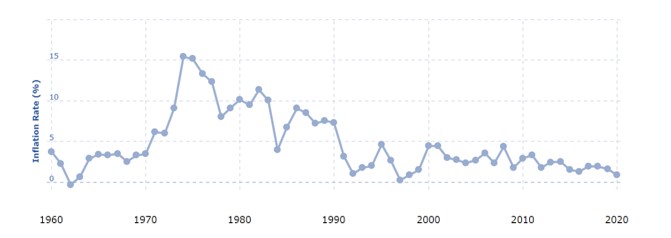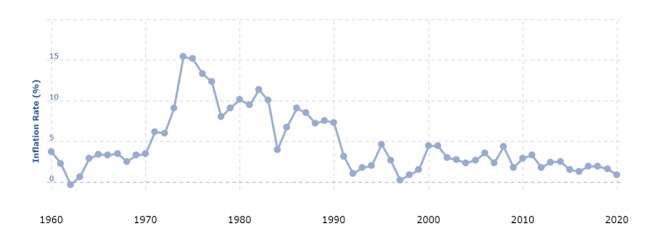
Global instability caused by the pandemic and the impact of the Ukraine conflict is driving up prices and destabilising global economies, causing analysts to fear the return of stagflation.
Commodities such as oil spiked dramatically in February and March, the price of staples such as corn and wheat have soared compared to the value at start of 2020, and European countries are scrambling to reduce their reliance on Russia’s natural gas, creating supply shocks.
At the same time, analysts fear many European countries, as well as the United States, could face a recession and revised down their growth outlooks, which could have a ripple effect on other economies, such as Australia.
That has drawn comparisons to the 1970s, when an energy crisis pushed up fuel and caused a spike in inflation, amid an economic contraction that affected most countries in the Western world, after decades of growth in the post-World War II era.
Australia did not escape the impact then, as the cost of living and unemployment surged. Now with inflation again trending upwards, are we set for a similar shock?
Stagflation – a throwback to the 1970s
Stagflation occurs when an economy is contracting while inflation and unemployment are rising.
Although the economy is slowing, the increasing cost of living leads to workers continuing to seek wage increases. Higher input costs for business contribute to higher unemployment as well as goods & services price increases.
Essentially, people are losing their jobs while the cost of living is rising quickly. It would be a major social and political problem.
This last occurred in Australia in the 1970s. In Graph 1, we can see inflation peaked above 15% in the mid-1970s, which is well above anything we have seen in the decades since.
Graph 1: Historic inflation in Australia

Source: Macrotrends, Australia Inflation Rate 1960-2022 [online], https://www.macrotrends.net/countries/AUS/australia/inflation-rate-cpi., (accessed March 9, 2022).
To avoid instability, governments seek to control inflation and have two broad tools at their disposal:
- Fiscal policy: Reducing government spending ie infrastructure, schools and healthcare and/or increased taxation.
- Monetary policy: Increasing short-term interest rates. This is intended to translate into higher loan costs for consumers and businesses, reducing their spending and putting downward pressure on demand.
During the 1970s annual GDP growth was also slowing from the higher rate of growth experienced in the 1960s.
Graph 2: GDP growth in Australia 1970 to 1980

Source: Macrotrends, Australia Inflation Rate 1960-2022 [online], https://www.macrotrends.net/countries/AUS/australia/gdp-growth-rate, (accessed March 9, 2022).
This put the government of the time in a difficult position; fiscal and monetary policy that could be used to fight inflation would also cause the economy to contract further.
The International Monetary Fund believes the stagflation environment was caused by “the interaction of commodity price booms in the early 1970s … with the wage-bargaining system”. It is also believed that central banks of the time may have contributed by not aggressively increasing interest rates.
The impact of stagflation on investments
Inflation reduces the purchasing power of investment income streams and companies, particularly in highly competitive industries, could see profit margins squeezed.
Those with pricing power will look to pass costs on to customers and protect their earnings.
Higher inflation expectations can see central banks react by raising interest rates, which reduces the demand in the economy, by making borrowing more expensive.
Interest rate rises flow directly into asset prices by reducing the present value of future cash flows, making assets with more value tied up in future cash flows less attractive.
As cash becomes more attractively priced than it was previously, we can start to see the impact in bond markets. Bonds lost 6.45%1 locally and 5.11%2 globally in the first quarter of this calendar year.
Another indicator is the Nasdaq index, which has a high proportion of tech-oriented or newer businesses. Cash flows in these businesses can be a long way into the future, and this market has dropped 10% to March 31.
Housing markets can be negatively impacted through tighter borrowing conditions for potential buyers, which leads to less development activity and higher unemployment as the economy contracts.
Coupled with a tougher jobs market and less economic activity, the outlook for many investments can be mixed, particularly in real terms.
The biggest concern is that inflation becomes out of control and volatile. This undermines confidence and makes business reluctant to invest – a further drag on growth.
In a moderate inflationary environment, higher quality real estate may perform relatively well as demand makes rental increases possible and rising construction costs restrict new supply.
Assets that have inflation-linked income may also provide a degree of protection, such as inflation-linked bonds, infrastructure and some types of real estate and shares.
What are the current inflation trends?
Some market commentators believe that inflation may soon be out of control.
Energy prices have increased, exacerbated by the risk of further sanctions on Russia, who represent 11% of the world oil supply.
Reduced oil production would only increase prices further and could slow economic activity. While oil prices have increased year-on-year, and may increase further, we have not yet seen prices on a scale of that seen in the 1970s (see Graph 3) – a key factor in that crisis.
COVID-induced global supply chain closures, as well as a broader reversal in globalisation, has led many companies to onshore key parts of their business – at greater cost. This adds to inflationary pressure while also reducing the growth prospects of emerging economies.
While we do expect growth to decline from recent levels, the elevated growth rate is due in part to the closure, then re-opening of global economies.
What about growth and unemployment?
Amid the uncertainty, the OECD estimates global economic growth could be more than 1 percentage point lower this year than was projected before the conflict.
In March, Goldman Sachs (NYSE:GS) downgraded its growth outlook for the United States and for the European Union, saying the “The Russia-Ukraine conflict has dented our previously optimistic views on Europe’s economic and asset market outlook”.
However, in Australia, unemployment sits at just 4.0% according to the most recent data from the Australian Bureau of Statistics, and the Reserve Bank of Australia has indicated the headline inflation rate is at 3.5%.
Will inflationary pressures be sustained?
The long-term outlook for inflation is not clear and there are two schools of thought.
Some believe that governments have been too slow to unwind the extraordinary measures taken to stimulate the economy during the pandemic induced lockdowns and that this has already fuelled the fire for longer-term inflation.
Conversely, others believe the current inflationary pressures to be short-term induced by disrupted global supply chains.
As supply chains re-open, inflationary pressures may recede with Australia returning to the low inflationary and low growth environment of the years prior to the global pandemic beginning in 2020.
Retaining a diversified portfolio during periods of heightened uncertainty is key. Speculation will continue but few, if any, can accurately predict what will happen in the future.
The best way to protect your wealth is to hold a range of assets that can continue to perform well across a range of environments, while not being overly exposed to any one single economic outcome.





